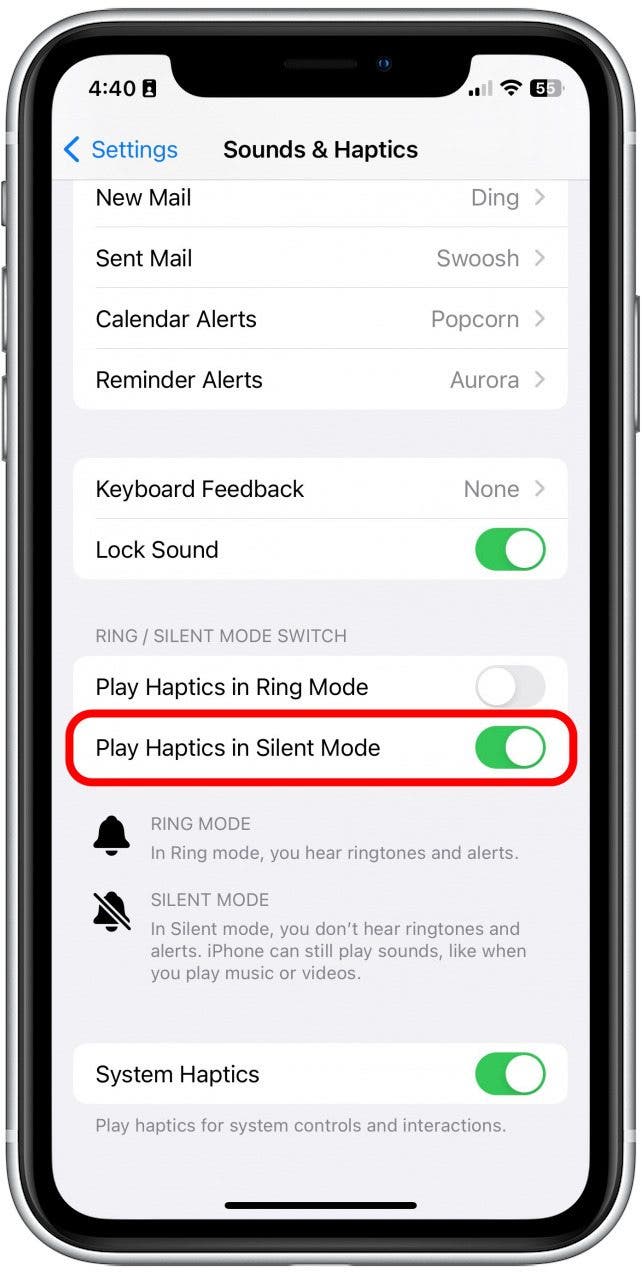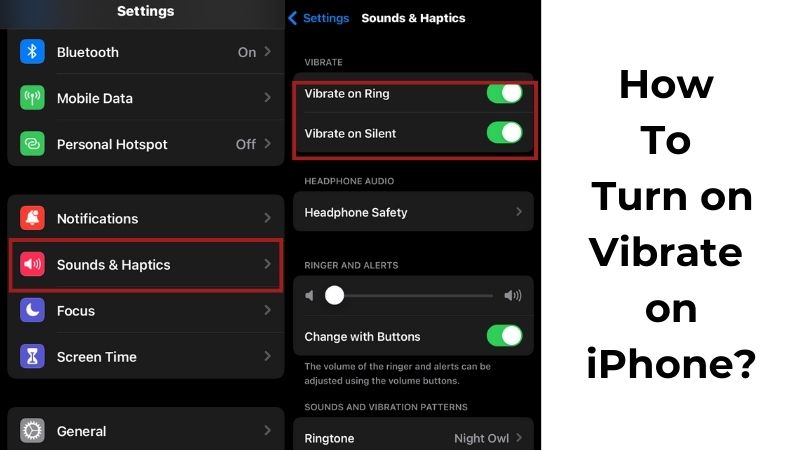How to turn vibrate on iPhone, go to Settings > Sounds & Haptics. Toggle on Vibrate on Ring and Vibrate on Silent.
In today’s digital world, smartphones are essential tools for communication and productivity. The iPhone, with its sleek design and advanced features, is a popular choice for many users. One crucial feature is the vibrate mode, which helps users stay alert to calls and notifications without causing disruptions.
Whether in a meeting, at the cinema, or in a quiet environment, vibrate mode ensures you don’t miss important alerts. Activating this feature is simple and can be done in a few quick steps. By enabling vibrate on your iPhone, you can maintain both awareness and discretion.
How to Turn Vibrate on iPhone?

Introduction To Silent Alerts
Silent alerts are important in many situations. They allow you to stay informed without disturbing others. Using vibration on your iPhone is a great way to achieve this.
The Need For Discreet Notifications
Discreet notifications are essential in places like meetings, theaters, or classrooms. A loud ringtone can be disruptive. Silent alerts ensure you remain connected without causing a disturbance.
- Meetings
- Classrooms
- Theaters
Benefits Of Using Vibration On Iphone
Vibration alerts on your iPhone offer many benefits. They help you stay aware of important calls and messages. You can also customize vibration patterns.
| Benefit | Description |
|---|---|
| Silent notifications | Receive alerts without noise. |
| Custom patterns | Create unique vibrations for different contacts. |
| Stay informed | Never miss important messages or calls. |
Follow these steps to turn on vibration:
- Open the Settings app.
- Tap Sounds & Haptics.
- Toggle on Vibrate on Ring and Vibrate on Silent.
These steps ensure you receive silent alerts. Discreet notifications help maintain peace. Customize your iPhone settings to suit your needs.
Navigating Iphone Settings
Turning on vibrate mode on your iPhone is simple. You just need to navigate through the settings. This guide will help you do that easily.
Accessing The Settings App
The first step is accessing the Settings app. Look for the grey gear icon on your home screen. Tap on it to open the app. This is where you control all the iPhone settings.
Locating Sound And Haptic Options
Once you are in the Settings app, scroll down. Find and tap on the Sounds & Haptics option. This section lets you adjust sound settings and vibrations.
In the Sounds & Haptics menu, you will see several options. Look for the toggle switch labeled Vibrate on Ring and Vibrate on Silent.
Toggle these switches to the on position. Your iPhone will now vibrate for calls and alerts.
Enabling Vibrate On Ring And Silent Modes
Vibrate on your iPhone helps you stay alerted without sound. This feature is useful in both Ring and Silent modes. Learning to enable vibrate is simple and quick.
Adjusting Vibrate Settings For Ring Mode
Follow these steps to enable vibrate in ring mode:
- Open the Settings app on your iPhone.
- Scroll down and tap on Sounds & Haptics.
- Find the Vibrate on Ring option.
- Toggle the switch to the On position.
Your iPhone will now vibrate when it rings. This feature ensures you don’t miss calls in noisy places.
Setting Up Vibration For Silent Mode
To enable vibrate in silent mode, follow these steps:
- Open the Settings app on your iPhone.
- Go to Sounds & Haptics.
- Locate the Vibrate on Silent option.
- Toggle the switch to the On position.
Your iPhone will now vibrate even when on silent. This helps you receive alerts without any sound.
:max_bytes(150000):strip_icc()/001_how-to-change-vibration-settings-on-an-iphone-6832805-4b49d218aa954c3c9bf2f96ca5117b99.jpg)
Customizing Vibration Patterns
Customizing vibration patterns on your iPhone can make notifications more personal. You can create unique vibrations for different contacts and notifications. This guide will show you how to do it.
Creating Unique Vibrations For Contacts
Making custom vibrations for contacts is easy. Follow these steps:
- Open the Contacts app.
- Select the contact you want to customize.
- Tap Edit in the top right corner.
- Scroll down and tap Vibration.
- Choose Create New Vibration.
- Tap the screen to create your pattern.
- Tap Save and name your vibration.
Choosing Patterns For Different Notifications
Different notifications can have different vibrations. Here’s how:
- Go to Settings.
- Tap Sounds & Haptics.
- Select the type of notification, like Ringtone or Text Tone.
- Tap Vibration.
- Choose a pattern or create a new one.
| Notification Type | Default Vibration | Custom Vibration |
|---|---|---|
| Ringtone | Default | Custom Pattern |
| Text Tone | Default | Custom Pattern |
| Default | Custom Pattern |
Using Do Not Disturb And Focus Modes
Turning on vibrate on your iPhone can be done easily. One way to achieve this is by using Do Not Disturb and Focus modes. These features help you manage your notifications efficiently. They ensure that you only get alerts when you need them.
Understanding Do Not Disturb
The Do Not Disturb feature silences all notifications. This includes calls, messages, and alerts. You can activate it from the Control Center. Swipe down from the top-right corner of your screen. Look for the moon icon and tap it. Your iPhone will now be in Do Not Disturb mode.
You can also schedule Do Not Disturb. Go to Settings > Do Not Disturb. Set the start and end times. Your phone will automatically switch to silent mode during these hours. This is useful during meetings or while sleeping.
Configuring Focus Modes For Silent Alerts
Focus modes offer more control over your notifications. They allow you to customize alerts for different activities. You can set up Focus modes for work, personal time, or sleep.
To configure Focus modes, follow these steps:
- Open Settings on your iPhone.
- Tap on Focus.
- Select a preset mode like Work or Sleep.
- Customize the settings for each mode.
You can allow calls from certain contacts or apps. This ensures you don’t miss important alerts. You can also create custom Focus modes. This is perfect for specific activities like studying or exercising.
Using Do Not Disturb and Focus modes ensures you stay focused. It helps you manage your time better. It also minimizes distractions. Activate these features to enjoy a more organized life.

Third-party Apps For Enhanced Vibration Control
Customizing your iPhone’s vibration settings can make alerts more noticeable. While built-in options are good, third-party apps offer more control. These apps allow for unique vibration patterns and intensity adjustments. This section explores how to select and integrate these apps for better customization.
Selecting Apps For Customization
Choosing the right app can be overwhelming. Look for apps with high ratings and positive reviews. Some popular apps include Vibrate Plus, Vibration Customizer, and Haptic Vibration Feedback.
| App Name | Features | Rating |
|---|---|---|
| Vibrate Plus | Custom patterns, intensity control | 4.5/5 |
| Vibration Customizer | Multiple profiles, easy setup | 4.3/5 |
| Haptic Vibration Feedback | Advanced haptic feedback | 4.6/5 |
Integrating Third-party Apps With Iphone Settings
After selecting an app, integration with iPhone settings is essential. Open the app and follow the setup instructions. Most apps will guide you through enabling permissions.
Next, go to Settings on your iPhone. Navigate to General, then Accessibility. Here, you can sync the app with system settings.
Enable the app under the Vibration section. This ensures your custom patterns work for calls, texts, and notifications.
- Open Settings
- Navigate to General
- Go to Accessibility
- Sync app under Vibration
Using third-party apps, you can achieve better vibration control. Customize patterns and intensity to fit your needs. This enhances your iPhone experience significantly.
Troubleshooting Common Vibration Issues
Is your iPhone not vibrating as expected? Sometimes, iPhone users face issues with the vibration function. This can be frustrating, especially when you rely on it for notifications. Here are some tips to resolve these common problems.
Resolving No Vibration On Incoming Calls
If your iPhone does not vibrate for incoming calls, check these settings:
- Go to Settings > Sounds & Haptics.
- Ensure Vibrate on Ring and Vibrate on Silent are enabled.
If vibration is still not working, try these steps:
- Restart your iPhone.
- Update to the latest iOS version.
- Check for any physical damage.
- Reset all settings. Go to Settings > General > Reset > Reset All Settings.
If the problem persists, contact Apple Support.
Fixing Intermittent Vibration Functionality
Sometimes, your iPhone may vibrate inconsistently. Here’s how to fix it:
- Check if Do Not Disturb is turned on. Go to Settings > Do Not Disturb.
- Ensure your iPhone is not in Low Power Mode. Go to Settings > Battery.
If these settings are correct, try these steps:
- Remove and reinsert the SIM card.
- Check for software updates. Go to Settings > General > Software Update.
- Backup your iPhone and restore it via iTunes or iCloud.
Persistent issues may need professional help. Visit an Apple Store for assistance.
Conserving Battery Life With Vibration Settings
Turning on vibration on your iPhone can drain the battery. By managing vibration settings, you can balance alerts and conserve battery life. This guide will help you optimize your settings.
Balancing Alert Needs With Battery Usage
Everyone wants to stay updated with notifications. Vibration alerts can be useful but can also consume battery. Finding the right balance is key.
- Use vibration only for essential notifications.
- Turn off vibration for less important apps.
- Adjust the intensity of vibrations in settings.
Avoid using vibration for every notification to save battery. Choose specific apps that need vibration alerts. This way, your phone uses less power.
Tips For Optimizing Settings For Battery Preservation
Optimizing settings helps in saving battery life. Here are some tips:
- Open Settings on your iPhone.
- Go to Sounds & Haptics.
- Turn off Vibrate on Ring and Vibrate on Silent.
- Adjust vibration patterns for specific contacts.
- Use Do Not Disturb mode during night hours.
Follow these steps to manage your vibration settings. It will help in extending your phone’s battery life. You can turn off vibration for calls and texts at night. This ensures your battery lasts longer.
Accessibility Features Related To Vibration
iPhones offer several accessibility features to help users with disabilities. One of these features is vibration alerts. These alerts can be customized to improve accessibility for those who are hearing impaired. Let’s explore how these features can enhance the user experience.
Enhancing Alerts For The Hearing Impaired
For users who are hearing impaired, vibration alerts are essential. They provide a tactile way to receive notifications. To enable these features, follow these steps:
- Open the Settings app on your iPhone.
- Navigate to Accessibility and tap on it.
- Scroll down to Hearing and select Audio/Visual.
- Turn on the Vibration switch.
These steps will help make sure you never miss an important alert.
Leveraging Haptic Feedback For Better Accessibility
Haptic feedback enhances the touch experience on iPhones. It provides subtle vibrations that can guide users through different tasks. To enable haptic feedback, follow these steps:
- Open the Settings app.
- Tap on Sounds & Haptics.
- Scroll down to System Haptics and toggle it on.
Haptic feedback can make navigating your iPhone easier.
Here are some benefits of haptic feedback:
- Improves touch experience
- Offers tactile guidance
- Enhances accessibility
Combining vibration and haptic feedback can significantly improve accessibility. These features ensure that users with disabilities have a seamless experience.
Conclusion
Activating vibrate mode on your iPhone is simple and quick. Follow the steps outlined to ensure you never miss important alerts. This feature helps maintain discretion in meetings and quiet environments. Customize it to suit your needs and enjoy a smoother, more convenient smartphone experience.



